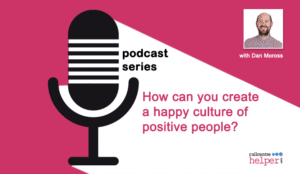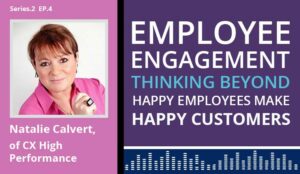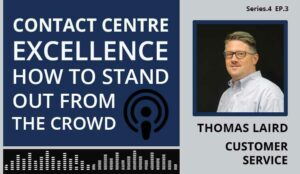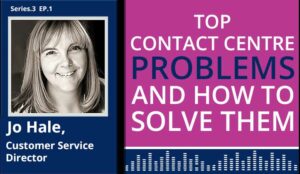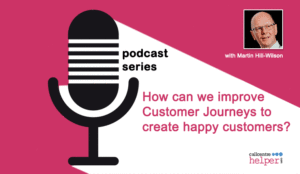
The Contact Centre Podcast: Episode Two
In this episode, Dan Moross of MOO draws on his own experience to discuss the keys to creating a contact centre culture that facilitates both learning and enjoyment.
As part of our discussion, we also talk about optimizing recruitment, bringing fun into the workplace and developing advisor skills.
To listen to the podcast directly from this webpage, just hit the play button below:
The Contact Centre Podcast – Episode 2:
How Can You Create A Happy Culture Of Positive People?
This podcast was made possible by our sponsor, Genesys. We now have a new link to visit their website, instead of the link mentioned in the podcast to request a demo.
So, to find out more about Genesys, simply visit their website
Podcast Time Stamps
- 1:55 – Hiring the Right People
- 5:13 – Welcoming New Recruits
- 8:46 – Helping Advisors Meet Their Potential
- 15:28 – Fun In the Contact Centre
- 21:16 – Giving Advisors the Right Tools
- 25:22 – Customer Experience Liasons
- 30:05 – Creating Initiatives to Improve Culture
Here is a Transcript to the Podcast
Charlie Mitchell: Good culture starts with hiring the right people, so what recruitment lessons have you picked up at MOO?
Dan Moross: So I think there’s some simple rules that we try and follow at MOO. The first one is around the speed at which you hire. And we have a phrase that we use across the business, not just in the contact centre, which is to hire slow and fire fast. I think quite often businesses are quick to get bums on seats, which means that you’re maybe compromising the quality of people that you’ve got.
So we want to make sure we spend the right amount of time getting the right person, and then, equally, if it’s not working out to make sure that we rectify that situation as quickly as possible.
The second, and I apologize for the slightly blue language, is that it’s better to have a hole in your team than an A-hole. Which sits with the first one as well. It’s again, I think, a constant checking yourself to make sure that you’re not hiring quickly just to fill a role because you have an opening, but actually it’s much more important to make sure that you have the right person.
So those are two just really quick rules or phrases that we use at MOO. But then following on from that, I think as we’ve grown, we really try to make sure that we’re hiring to our values. You can train for skills, but you can’t really train for behaviours, so making sure that you’re hiring people that are going to be a really good fit with your team and with your organization’s values. You can’t teach those things, so once you’ve nailed that and you’ve got the right person in the door, you can train them for the skills that you want to have within the team, so that’s really important.
And I think finally, as you’re really starting to scale the team, making sure that you design essentially a repeatable process, so that as the contact centre grows or as people get promoted into more managerial roles, you want to make sure that the new blood is hiring to the same standards and in the same way as maybe the more senior members of staff. I think quite often in a fast-growing contact centre or one where there’s a lot of hiring going on, you find that there’s inconsistency across different people that are doing the hiring. So, having that stuff written down and really hashed out and agreed across all of the hiring managers is really important. And again we’ve got scorecards and different things to help us do that, and it all ties back to our values and behaviours really.
Charlie: Yeah. I was going to ask from what you just said there, is whether you have the traditional one-to-one interviews or do you perhaps have open days for new recruits to assess these values in person?
Dan: So we still tend to have one-to-one interviews, sometimes it’s more a two-on-one, but generally speaking, that’s more a consequence of how many roles we might have to fill at one time and how many potentially qualified applicants we have in other areas close to the customer service unit, but also I guess a contact centre role in the sales team.
Sometimes we spin out whole sales units at one time, and sometimes we do what we might call an assessment centre or an assessment day, which would be kind of an open day where we bring a bunch of different people. But typically, from a customer service standpoint, just because of the needs that we have and the speed at which we’re hiring, it ends up being one-to-one.
Charlie: Excellent. I think it’s quite interesting. There’s some brilliant points there about key tips for recruiting the right people. But in their first week or so, it’s hard for anybody to start a new job, so what do MOO do to welcome new employees into the contact centre?
Dan: Well, I think actually tying in to your question about open days and assessment centres, one of the things that we’ve tried to do recently, and it’s hard again, based on how many hires you’re making, is to try and bundle hires to start on the same day. If you’ve got one person starting one week and another person starting the next, you can get your training out of kilter. So you get a lot of economies of scale from having a bunch of new starters on the same day – can really be very beneficial to your training program. And then once people do start at MOO, we’ve got a bunch of MOO-wide things to help welcome people to MOO, and we have some contact-centre specific stuff.
So if I just stay on the MOO-wide stuff, and we’ve got a number of different intro workshops that is mandatory for any new starter at MOO to attend. And that includes an intro to the brand, an intro to the technology and product team, an intro to the customer, which goes through essentially why customers are important, what different types of customers we serve. Then they also have a half-day warehouse manufacturing tour where they can actually go and see our product being produced and manufactured. And then as we get… I think once a quarter, we take all new starters and they have lunch with our CEO, which is really, really informal, it’s almost just like a round table, and there can be anywhere up to 20 or 30 people in those lunches. Lunch is catered by MOO so we bring lunch in for everybody.
Richard, who’s the CEO, does give kind of a history lesson about how he started MOO, why he started it, the mistakes he made along the way. Talking about some seminal moments, I guess, in MOO’s history, but it also just gives people the opportunity to get to know him, ask questions; it’s very informal. And that really helps to give people this feeling of being part of the bigger picture, which is great, especially for the contact centre folks who maybe can typically feel a little removed, especially from the C suite.
Then from a customer-service specific side, we have a dedicated onboarding program which has a lot of training, detailed training schedule, but there’s lots of other bits dotted in to help get people feeling at home. So we have, and I’m probably going to get this slightly wrong, but we have something called, one fact, two lies, where all new starters have to submit three facts. One will be true and two will be a lie. And then in our weekly or fortnightly team meeting, we do a bit of a quiz about the new starter.
We don’t have any weird induction things where we make people stand on a chair and sing a song, but we do encourage those new starters to share information about them and get to know their team better. Their training schedule will be a mix of classroom quizzes and learning mixed in with on-the-job training, lots of shadowing, but really we just try to do as much as possible to make them feel both welcome and part of the culture as much as a part of the team that’s actually performing. It’s as much about the work as the culture.
Charlie: Yeah absolutely. I think it’s great to hear all of these real-life examples for actually breaking the ice. Because I know if you’re fitting into a culture as a new employee, and it can all be a bit daunting on your first few days. But I think one key thing that really stood out for me there was getting people into groups as well. So they all join in together, so it’s that sense of camaraderie already, which is great. And it’ll be great to hear even more examples of what you do at MOO past that and what you do to improve advisor development both in the contact centre and for their wider career.
Dan: Sure. So I think, typically I think it’s a three-month probationary period when someone joins MOO. And it used to be actually that our onboarding training was around that long, we’ve actually managed to reduce that by having a dedicated team that’s doing that training. But once they are onboarded fully and they’re answering phone calls and live chats and they’re responding to emails, there’s still a huge amount more for them to learn both, like you said, within the contact centre, but also skills they might want to apply elsewhere.
I mentioned before, we’ve got a full-time training and enablement team and they provide coaching. So during quality reviews or one-on-ones, if we’re identifying opportunities for that person to improve in a specific type of problem maybe they deal with, with customers, they’re not so hot on, or maybe they want to learn how to take some escalations and they want some training.
There’s tons of different, it sounds really formal, but I would say components to the training regime that we have at MOO. And it’s about identifying which of those components fit best with the employee at different times, and that’s available forever, you can redo as many of those components as you like.
On top of that, we do actually, I must say, I’m not sure exactly how this works today in the contact centre – probably a little bit removed – but we do actually have a learning and development budget at MOO that’s a pot of money, a virtual pot of money, probably not a real pot of gold, but for team members to utilize on request essentially. So if there was a conference or a specific skill you wanted to go to or achieve and there was a specific training thing you could do externally, then it’s just a question really of speaking to their line manager, and we’d do everything we can to make that a reality.
There’s only so far, I guess, you can go in giving people skills that are not relevant to their current job, but if there are things that they’re passionate about to develop in their own career, we do our best to support those as long as it wasn’t contradicting their current path. And then something MOO-wide that we’ve actually rolled out in the last year, year and a half, is a – it sounds really grown-up – but a career development program, which takes every single department essentially, works out what the different levels within each department are, and they would be able to sit, you’d be able to look across all of the company at the different levels and how they match up. And then with each level and within each career family or job family, there’ll be a bunch of different capabilities, core capabilities or expert capabilities, with subject-matter expertise.
Dan: So that anyone in their current role can look at… let’s say I’m working in the contact centre and I want to work in the engineering team, I can look at what level I’m currently on and I can see what other levels are next to or just above mine in another department, say engineering. And then I can look at what capabilities I might need to develop or what behaviours I have to exhibit if I was to even consider being able to move either into that department or an upper level in my current department. So we’ve tried to paint this snakes-and-ladders picture so people can see where the ladders are and what skills they need to develop in order to climb them, but where that’s manifested itself in the best possible way. Historically, it was probably actually before we had that really developed career pathing framework, and a lot of it involves the secondment and actually people cutting their teeth in other roles while still in a contact centre job.
Dan: We had someone who was in the contact centre, kind of supervisor-ish level, who went and did a secondment in the engineering team. He worked there for, I think, three months, and then at the end of it they said, “Well, we’ll give you a job,” so he moved into that department. And we’ve had people move into IT and desktop support. Obviously there’s lots of similar capabilities in that role as there is in the contact centre. Lots of people moving over into sales, which obviously has lots of complementary capabilities, but in order to make that jump, they had to develop additional capabilities that they would have seen by looking at those career development paths.
Charlie: I think that’s great. I think so often you go and talk to contact centres and they talk about a progression path, but it’s very informal. So to hear that you’ve mapped out those capabilities and those skills and told advisors what exactly they need and it’s very clear what they need to do to become skilled in the area, I think that’s great.
Dan: I think there are two things I want to add. The first is, it’s one thing to try, and I really want to emphasize the word try, and plot out those things and share them with people, it’s another to really put them into action. It’s a very difficult task. And even once someone has started to try and develop some of those capabilities, that doesn’t mean the next role or a promotion is you’re a shoe-in, it’s all about supply and demand essentially. If there aren’t any roles available, then there aren’t any roles.
Dan: So I think you have to temper all of this optimism with a dose of harsh reality, which is if we’ve got 75, 80 people in the contact centre, there might only be 5 open roles at any one time in MOO and in other departments, so not everyone’s going to get the opportunity. And even if you do spend the time learning new skills and capabilities, it doesn’t guarantee that you’re going to find a new role. So, I think there’s almost another strand of all of this, which is about open and honest two-way communication and really giving them a dose of reality to set realistic expectations.
Charlie: Yeah. I think as well that by having such an actionable path, you’re not only increasing the chances of them getting another job within MOO, though, but you’re enhancing their overall employability. Obviously you want to keep your best people, but you’re providing them with the skill set to go out, and they’ll be thankful for that.
Dan: For sure. I think it’s probably something that in the old years, in the old days, it probably wasn’t so normal. But I definitely feel, think and hope MOO feels similarly, that we just want what’s best for every individual, whether it’s staying at MOO or not, and where people want to develop skills that they might want to utilize externally, that’s just as valuable to us. The story that they’ll tell people, the people they might refer to come and work at MOO from that experience is massive.
Charlie: And I think, on that subject of bringing the best of employees’ needs, the best environment, and I guess that comes back to bringing fun into the call centre. What have you found at MOO works really well in terms of bringing that atmosphere of fun?
Dan: Yeah, I mean I think there’s lots of trials and varying levels of success when it comes to this stuff. I think what we found is, I don’t know what percentage, but let’s just say 50%, of what you do needs to be powered by the team. No one likes to be forced to have fun by someone else, so we’ve tried to really empower the teams to come up with some of the things that they think are fun. And that’s really simple things like giving teams a monthly budget for social activity, for going out or playing games or whatever. And then not just giving the budget, but then actually passing the baton to different people every time to organize all that activity. So we have, for example, in the UK contact centre there’s a monthly social. And each time it’s a different two people in the contact centre that own picking the date, picking an activity, and it’s all sorts of things from ten pin bowling, to escape room, to even just going and eating pizza and drinking beer. But just giving them the power to decide what it is that they want to do.
Dan: And then on top of that we obviously have a whole load of top-down, but mainly probably based on feedback from the contact centre agents. Things like, we have a bunch of different games and fun activities during really busy periods, which sounds a little bit counterintuitive, but it’s really just to keep them alive and kicking during a period where they probably do feel like they’re just tied to their desks. And we have things like buzzword bingo, we used to have a game called “Guess Who”, which was essentially like the game Guess Who but with contact centre agents as the people. We have other fun games and activities during sale periods like happy hours and stuff like that. Then we’ve also got really much more formal things like rewards and recognition programs, and we have two really interesting parts of this. The first is peer-to-peer nominations, so people can nominate their colleagues for outstanding service or helping either to customers or to colleagues. So you get these peer-to-peer nominations and people are picked as winners. And I can’t remember the exact prize, but I think it’s probably like Amazon vouchers.
Dan: We do also have some more informal rewards which are around our “Wheel of Wow”, which I must say I think is actually currently out of action. But this is something we bought on Amazon. It’s a spinning wheel like the Wheel of Fortune, and on every piece of the pie is a different thing you can win. And it was things as simple as half an hour to play pool with a friend or table tennis, a free bottle of wine, or an extra half an hour for lunch, or go home early an hour, so lots of really small little things but quite valuable if you are answering the phone all day. And then the icing on the cake is something called the passport program. We actually stole this from our sales counterparts, and this is where people can self-nominate, they write a written application about why they want to win the passport program for that specific thing.
It’s every quarter or every half year, and what they win is they can go and work in another MOO office of their choice. So they could go to the US and work in our Denver office or they could go to the US and work in our East Coast office. And that again is a really nice perk, and really just, again, there’s lots for them to learn by going to see another MOO culture, but also just another culture. A lot of our US colleagues, for example, have very seldom come to the UK, so that’s often a really big draw.
Charlie: Yeah, I think it’s a great thing, there’s so much variation there in those incentives for fun that you suggested. And it’s especially poignant for me, because I’ve recently come across a few contact centres who’ve told me… they’ve said that they’ve offered incentives before for a few weeks just to get teams through the busy periods. Then at the end of the busy period it was no longer an incentive and it was an expectation.
Dan: Yeah.
Charlie: Is this a problem that you’ve come across and actively combated?
Dan: I think so. And I think that’s, like I said before, even though some of these had been mandated by the management, it’s all based on what feedback they get from the team. So, we might get to, at the end of this year, we’re always in the same way that you would survey your customers and determine what parts of your service you should improve or what new features to add, I think you have to do that with the contact centre. And there is this inflation I guess, but maybe it’s about keeping it fresh. So maybe it’s not just that they might think that something is now table stakes, but that something could change and that could delight them more than the old thing. So, I think keeping it fresh and making sure you’ve always got something on the go is important. But yeah, I guess you could say the same about any perk. You could say once someone’s got one pay rise, they’re just always looking for the next pay rise, isn’t it, it is kind of true. It’s about trying, again, I guess to temper expectation.
When this all leads back to under-promise and over-deliver, and making sure that people have the right expectations. It’s definitely true from a customer experience standpoint, you want your customers to have the right expectations and you want to exceed them, or at least delight them by meeting them. And I think it’s the same for employees, but I think businesses, and contact centres more so, need to do a good job of grounding people in. And the reality is, the realities of their job and their workspace, to make sure that they are delighted when things are better than what they expect. Does that make sense?
Charlie: Yeah, it does. And I think one of those realities that advisors can become frustrated with sometimes, and that impacts on the culture, is the tools and systems that a contact centre has, which can be a real source of adviser frustration. What tools and systems have you implemented to help to improve culture?
Dan: Again, we try to listen to what our agents tell us. And there are sometimes opportunities to make quick gains by improving specific bits of tech. I think the biggest pain points tend to be the most cumbersome pieces of technology unfortunately. I mean just going – I go back eight or nine years and we used to use… I don’t want to name-drop and bad-mouth this piece of technology, but we used to use one of the biggest sales management tools in the world for our contact centre. And we only had four or five agents, and it was abundantly clear that it was not pleasant to use, there was too many clicks. It was a really big pain point and it was damaging people’s morale, but it was also inefficient and slow and costly. So, we dropped that system and we went to a new one, but that was a massive overhaul. And at that point there was, like I said, only five or six agents. Now, where 80 agents across two or more locations, moving that big system would be a really big task. That said, we’ve done a lot of work to iterate within the systems that we have, so rather than unplugging and plugging in a new one, just giving the pigs some lipstick, if you like, trying to improve things. So we use disparate systems – we tried to pick a best in class and stitch different bits together.
And where we found pain points in potential lack of visibility between two channels or two systems, we’ve tried to do our best to build small improvements to the agent desktop to make some of that easier. But on top of that, we do have two bits of technology that we’ve… one that we implemented about two years ago and one that actually as a company we implemented a couple of… probably about four years ago. So the one we’ve done in the contact centre is a quality assurance tool called MaestroQA, and that is less for the agents and actually more for the supervisors. So we were using a mess of spreadsheets and third-party software to try and listen to calls and score them. And the tech just wasn’t working and the amount of heavy lifting that the supervisors had to do was meaning they had less time to actually sit and help their agents and give them feedback and coaching. They spent too much time in the weeds.
What Maestro does, again, it brings all of that into Zendesk; it plugs directly in. So you can go into Maestro and pull up “I want five random interactions from this channel” and it will serve them up, and then you can score them right there. And then once they’re scored, you can look at that ticket in Zendesk and see the score, so they’re interwoven together. So that’s been massively useful for the supervisors, and I think probably in turn, been useful for agents and certainly improved the – it’s hard, right? – that doesn’t really improve the culture, but it definitely improves morale and engagement.
Charlie: Well I think, as you said, it gives the people who are in charge of quality more time with the advisors, and that helps to build more of a learning culture.
Dan: Absolutely.
Charlie: So, they’ve kind of, yeah.
Dan: I was just going to say, the other thing that we implemented at a company-wide level, we have a piece of software called Small Improvements. It’s what we use for 360-degree feedback and performance reviews, but it has another element built in, which is essentially recognition. So you can award or give a shout-out to any member of staff in the organization and award them a specific badge, like a fake digital badge. And each badge, we have badges, one badge for each of our company values, but there are also other things just like, great teamwork, or went above and beyond, or delighted a customer, or whatever. And that allows without monetary reward or even having to get up on a sandbox and stand there and shout out for someone, you can really quickly fire off praise and recognition to other members of staff. And that certainly helps build that culture of continuous feedback and recognition.
Charlie: Excellent. And I know one other key part of MOO that has really helped to build the great culture you have there is initiative. You have good customer experience liaisons. How does this initiative work and how can it help to improve the culture?
Dan: So I think I’ll tell you a little bit about it, how it works, but I will say I think this is less about how this initiative could improve culture, but more what it stands for. And in a nutshell, employee culture or work culture is just about how well we all get on and interact and work together essentially, as far as I’m… that’s the way that I think about it. And what customer experience liaisons sought to do was actually address a cross-functional working problem, a collaborative problem that we had between the contact centre and the rest of the organization.
As is common in most semi-large businesses, we’re about 600 people in total at MOO now, but we probably started it when we were close to 400. You have the contact centre which can be the last thought of the rest of the organization. So, you might have a group working on developing a new feature for your website or a new product or a new service that you’re going to offer. And typically maybe the director of customer experience or that or the director of customer service knows it’s happening, but actually making sure that the agents know it’s happening, are prepared for it, and feel involved, was often missed out and didn’t happen enough.
So what we sought to do was take one or two customer service agents, and we gave them this kind of interim non-official title of customer experience liaisons, and we inserted them into these working groups that were working on new services, products and features. And it served as two things; it was a two-way communication benefit. The first is the customer service agent, the CX liaison, is representing the customer and the contact centre. So they are providing information about… if they’re talking about some features that are going to be part of the new product, the liaison can give feedback on “Well, I think this is going to cause a lot of contacts in the contact centre. This is what customers are likely to say they don’t like about it,” or “In my experience, I hear a lot of comments about this. Maybe we could change this feature to do that instead.” So representing the customer in the contact centre.
And then the second, which was not the original intention but actually becomes, I think, it’s almost more important than the first thing that I mentioned, is that it gives that liaison the opportunity to take back all of the things that they saw happen in that working group and take it back to the contact centre. So that everyone who’s on the phones or on chat or on email knows what’s going on, they know what’s coming. We can talk about it as a group. We can identify new training we need to do or new content we need to write in FAQs, and it just means that we’re all part of the same initiative. So, that’s really valuable, to make sure we’re building the right thing outside of the contact centre because it’s had customer input, but also that the customer service team are equipped and ready for the new thing that’s going to come. And the output of that, really simply, is much better relationships between the two parts of the organization, the contact centre, and the rest, the us and the them. And it lets agents work on things that they wouldn’t otherwise do.
Dan: I think probably one of the hardest things as a contact centre agent is just the boredom that’s associated with sitting and doing the same thing every day on repeat. Getting away from your desk, even if it’s just for half an hour or an hour a week. Conversing with people who operate in a slightly different part of the business, maybe have a different culture within that part of the business, get to experience that and it’s part of career development, I guess, that level of involvement. And the final consequence, and again I’d say this is more important for the context into culture than anything, is that CS has become more of a key component as we do things. At the kick-off of a project now, customer service is on the list, whereas in the old days it was, “It’s going live tomorrow, do you think we should tell the contact centre?” Now they want the customer service agents to be involved, they value their ideas, they want their input during the exploration phase, rather than just expecting them to sweep up the pieces once something happens.
Charlie: Yeah, I think it’s great that you have all these opportunities for advisors to explore other areas of the business. I mean, you go into so many contact centres where the only contact they have with the outside business is a video message from the CEO every certain amount of months. So, it’s great to hear that there’s so many opportunities for advisors to travel around. And I guess that helps to bring the voice of the customer into other areas of the business as well, which is an important part.
Dan: Yeah, I think one thing I do want to add as a caveat like, given these sort of updates and telling stories about all the good things is very much, it’s all the good stuff. Not all of this stuff works all of the time and sometimes things don’t always go to plan, but you can only put your best foot forward and try to come up with initiatives that really symbolize and address the needs of your people and the business.
Dan: And some of the stuff sticks and stays, sometimes they have peaks and troughs and CX liaisons – as I said, I think we’ve been doing it for two years – it’s had stuttering moments. We started it with a big bang, it went really well, a few people leave, the direction of specific working groups might change and people drop out, and then you have to light a new fire to get it going again. So they’re not one-hit wonders, you can’t just set them up and then just expect them to happen. You really have to pay attention to them, nurture the program, nurture the initiative, and if it starts to fail, either stop it quickly and start something else, or light the fire underneath it and get it back on track.
Charlie: Excellent. I think that’s all really great insight. Thanks for sharing this all with us, Dan. Is there any place our listeners can come and follow you on social media?
Dan: Yeah, I think probably the best place is LinkedIn. Just search for Dan Moross or Daniel Moross, and you’ll find me. I’m always willing to chat with people over coffee or over the internet in some way. So if you want to ask any questions or whatever, just look me up.
Author: Rachael Trickey
Published On: 5th Aug 2019 - Last modified: 22nd Apr 2024
Read more about - Podcasts, Charlie Mitchell, Culture, Dan Moross





